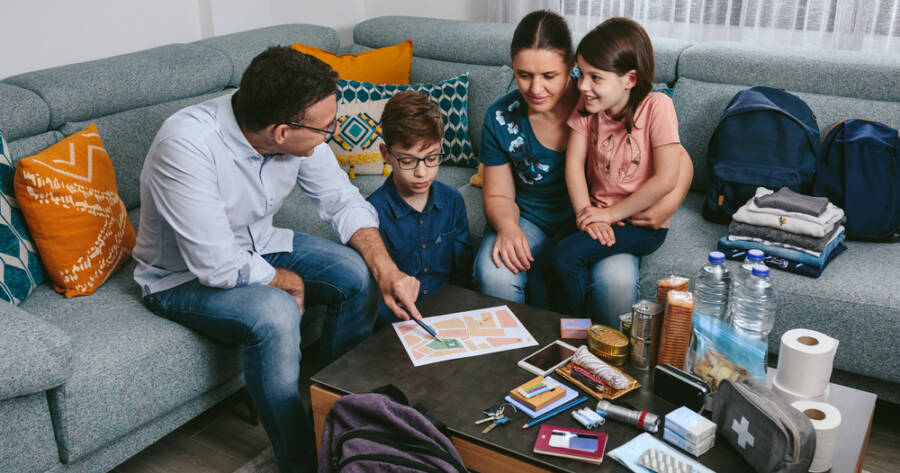Unexpected emergencies can happen anytime, from natural disasters to power outages and medical crises. Having a solid plan in place ensures that every family member knows what to do, where to go, and how to stay safe. Preparedness isn’t just about gathering supplies—it’s about clear communication, practiced responses, and staying calm under pressure. By creating a family emergency plan tailored to your needs, you can protect your loved ones and face any situation with confidence.
Creating a Family Emergency Communication Plan
When disaster strikes, staying connected is critical. Every family should have a clear communication plan that outlines how to reach one another in case of separation. Designate a primary meeting spot near your home and an alternative location outside your neighborhood in case evacuation is necessary. Each family member should memorize important phone numbers, as cell networks may be unreliable.
Consider choosing an out-of-town emergency contact who can relay messages if local lines are down. Having a written list of emergency contacts, including doctors, neighbors, and local shelters, ensures that everyone knows where to turn. Practicing emergency calls and text messages helps children and adults feel more prepared when urgent situations arise.
Building an Emergency Supply Kit
A well-stocked emergency kit is a must-have for any household. Essential supplies include non-perishable food, bottled water (one gallon per person per day), flashlights, batteries, a first-aid kit, and a multi-tool. Store everything in a durable, waterproof container that’s easy to grab in an evacuation.
Don’t forget personal items like prescription medications, extra eyeglasses, important documents, and pet supplies if you have animals. Consider adding comfort items for children, such as small toys or books, to help ease stress during an emergency. Keeping a battery-powered radio and a solar charger ensures that you stay informed if power is lost for an extended period.
Establishing an Evacuation Plan
Knowing how to evacuate quickly can be lifesaving. Identify multiple exit routes from your home and ensure every family member knows where to go. Local shelters, family friends, and nearby hotels should be part of your evacuation plan. If you have pets, research pet-friendly shelters in advance.
Prepare a “go bag” for each person with essentials like clothing, hygiene products, and snacks. Keep your vehicle’s gas tank at least half full in case of sudden evacuation orders. Practice evacuation drills twice a year to ensure everyone moves quickly and efficiently under pressure. The more familiar the plan, the easier it will be to execute during a real emergency.
Teaching Kids Emergency Preparedness Skills
Children may feel anxious about emergencies, but preparation can help them feel more in control. Teaching kids when and how to call 911 is crucial. Make sure they know their home address, emergency contacts, and safe locations if they need help.
Turning preparedness into a game can make learning more engaging. Practice fire drills with a stopwatch, have kids locate emergency exits in different buildings, and quiz them on safety scenarios. Teaching children basic first aid skills, such as applying bandages or recognizing signs of dehydration, empowers them to help themselves and others in critical moments.
Preparing for Different Types of Emergencies
Not all emergencies are the same, so families should prepare for different situations. Natural disasters like hurricanes, wildfires, earthquakes, and floods require specific responses. Learn the risks in your area and create a plan tailored to those threats.
Other emergencies, such as house fires, medical incidents, or power outages, also require quick thinking. Smoke detectors should be tested monthly, and fire escape routes should be mapped out. For medical emergencies, ensure that all adults and older children know CPR basics and how to stop bleeding. Being prepared for multiple scenarios keeps your family ready for anything.
Staying Informed and Adapting Your Plan
Emergency preparedness is an ongoing process, not a one-time task. Stay informed about local threats by signing up for emergency alerts from your city or state. Weather apps, NOAA radios, and community notification systems can provide real-time updates.
Revisiting your plan regularly is just as important. Update emergency contacts, refresh supplies in your emergency kit, and adjust evacuation routes as needed. As kids grow older and circumstances change, make sure every family member stays aware of any modifications. A well-maintained plan ensures your family is always ready to respond effectively.
Peace of Mind Through Preparation
A solid emergency preparedness plan gives families the confidence to handle unexpected situations with calm and clarity. Knowing that everyone has a role, supplies are ready, and communication is set reduces panic and increases safety. While no one can predict emergencies, being prepared makes all the difference when it comes to protecting your loved ones and responding with confidence.

